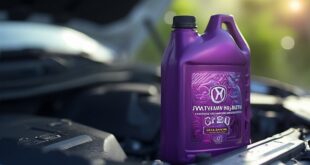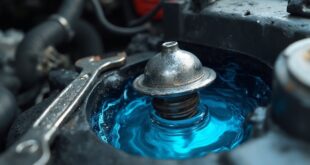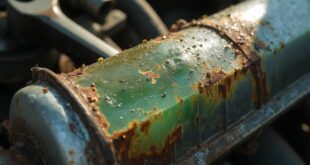HOAT coolant, or Hybrid Organic Acid Technology coolant, combines the strengths of Organic Acid Technology and Inorganic Acid Technology. This blend protects your engine from rust and corrosion while ensuring ideal temperature regulation. It lasts up to 100,000 miles or 5 years, making it a practical choice for vehicle maintenance. Remember, understanding the different types of coolant can help you make better decisions for your engine's health, and there's more to learn about coolant options available to you.
Definition and Composition of HOAT Coolant
HOAT coolant, which stands for Hybrid Organic Acid Technology, combines the benefits of Organic Acid Technology (OAT) and Inorganic Acid Technology (IAT) to provide effective engine protection.
It typically comes in various colors like yellow, purple, blue, pink, and turquoise. One of its key features is the inclusion of silicates, which help prevent rust and corrosion.
You can expect a recommended service life of up to 100,000 miles or 5 years, making it a reliable choice for many vehicles.
Understanding this coolant's composition guarantees you make informed decisions about your engine's maintenance and longevity.
The Role of Coolant in Engine Performance
While many might overlook its importance, coolant plays an essential role in maintaining engine performance. It regulates temperature, preventing overheating and freezing, which could lead to serious engine damage. By raising the boiling and freezing points of engine fluids, coolant guarantees your engine operates efficiently in various conditions. This protection minimizes corrosion, extending the engine's lifespan.
| Function | Benefit |
|---|---|
| Temperature Control | Prevents overheating |
| Freezing Protection | Prevents freezing |
| Corrosion Resistance | Extends engine life |
Advantages of HOAT Coolant
One of the key advantages of using HOAT coolant is its exceptional protection against rust and corrosion. This hybrid formulation combines the best aspects of OAT and IAT, ensuring your engine remains safe from damage over time.
Additionally, HOAT coolant has a long service life, lasting up to 100,000 miles or five years, reducing the need for frequent changes. Its unique silicate content enhances the protection offered, while also helping to keep your engine running smoothly in various temperatures.
Ultimately, choosing HOAT coolant means you're investing in your vehicle's longevity and performance, ensuring peace of mind on the road.
Comparing HOAT, OAT, and IAT Coolants
When it comes to choosing the right coolant for your vehicle, understanding the differences between HOAT, OAT, and IAT coolants can make all the difference in engine performance and longevity.
HOAT combines the strengths of both OAT and IAT, offering excellent corrosion protection with a lifespan of about 100,000 miles.
OAT lasts longer, up to 150,000 miles, but lacks some of the rust protection HOAT provides.
IAT, while effective, has a shorter service life and is more prone to corrosion.
Knowing these distinctions helps you select the right coolant for your engine's needs, ensuring peak performance and durability.
How to Choose the Right Coolant for Your Vehicle
Choosing the right coolant for your vehicle is essential for maintaining ideal engine performance and longevity. Start by checking your owner's manual for specific recommendations. While color can provide clues, it shouldn't be your only guide. Consider factors like the coolant's lifespan and its protective properties. You can also consult local dealerships or find PDF versions of your manual online for accurate information. Here's a quick comparison to help you decide:
| Coolant Type | Lifespan |
|---|---|
| HOAT | 5 years/100,000 miles |
| OAT | 10 years/150,000 miles |
| IAT | 2 years/30,000 miles |
| Price | ~$30/gallon |
Frequently Asked Questions
Can I Use HOAT Coolant in Older Vehicles?
You can use HOAT coolant in older vehicles, but check your owner's manual first. Mixing it with IAT or OAT coolants isn't recommended, as it may reduce effectiveness and protection for your engine.
What Happens if I Mix HOAT With Other Coolant Types?
Mixing HOAT coolant with other types can reduce its effectiveness, leading to corrosion and overheating issues. It's best to stick with the recommended coolant for your vehicle to guarantee peak performance and longevity.
How Do I Know if My Coolant Is HOAT?
To identify if your coolant is HOAT, check its color—typically yellow, purple, blue, or pink. Consult your owner's manual for recommendations or contact a local dealership for specific coolant type information.
Is HOAT Coolant Safe for All Engine Types?
HOAT coolant isn't universally safe for all engine types. Check your owner's manual for specific recommendations. Using the wrong coolant can lead to corrosion or overheating, so always verify compatibility before adding any coolant.
How Often Should I Check My Coolant Levels?
You should check your coolant levels regularly, ideally every month or before long trips. Maintaining proper levels guarantees your engine stays cool, preventing overheating and potential damage. Don't forget to inspect for leaks, too!
 Car Service Land Coupons for Oil change, Tires, Wheel alignment, Brakes, Maintenance
Car Service Land Coupons for Oil change, Tires, Wheel alignment, Brakes, Maintenance




